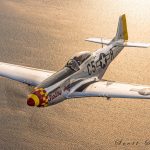Platinum Fighter Sales recently listed a remarkable 1944 A-26B Invader known as “Sugarland Express.” This A-26B-61-DL Invader (N167B), constructed by Douglas at Long Beach, California, has a storied history encompassing military service, private ownership, and meticulous restorations that have preserved its iconic legacy.

Douglas officially delivered the first production model A-26B aircraft to the USAAF on 10 September 1943. These aircraft were sent for field evaluation during combat operations with the Fifth Air Force in the Southwest Pacific Theater. The A-26 first saw action on 23 June 1944, when four aircraft attached to the 3rd Bombardment Group’s 13th Squadron (“The Grim Reapers”) bombed Japanese-held islands near Manokwari. Additional USAAF units in the Pacific that previously operated A-20s or B-25s received limited numbers of A-26s for trials.

The 319th Bomb Group fully converted to the A-26 in March 1945, commencing operations with the 3rd Bombardment Group. By August 1945, after conducting a few dozen missions, it became evident that the war was nearing its conclusion, leading to a winding down of operations. The 319th officially ceased combat missions on 12 August 1945.

Seeking better results from the Invader’s second combat test, A-26s were ferried to Europe in late September 1944 for assignment to the Ninth Air Force. Eighteen aircraft and their crews were initially deployed to the 553rd Squadron of the 386th Bomb Group, flying their first mission on 6 September 1944. With no losses reported over eight test missions, the Ninth Air Force declared the aircraft satisfactory and began replacing their A-20s and B-26s with A-26 Invaders.

The first group to convert to the A-26B was the 416th Bombardment Group, which entered combat on 17 November 1944. Shortly after, the 409th Bombardment Group followed, though both groups operated a mix of A-20s and A-26s until deliveries of the A-26C variant caught up. The A-26 excelled in bombing, strafing, tactical reconnaissance, and night interdiction missions, earning praise from pilots and crews alike. By 1945, the Ninth Air Force’s A-26s had flown 11,567 missions, dropped 18,054 tons of bombs, recorded seven aerial victories, and lost 67 aircraft.

In January 1945, Italy’s Twelfth Air Force’s 47th Bomb Group began receiving A-26s. These aircraft were used against German transport links and for direct support missions targeting tanks and troop concentrations in the Po Valley during the final campaigns in Italy.

Based by the history provided by Aero Visuals, the subject aircraft, serial number 44-34602, was taken on strength by the United States Army Air Force (USAAF) in 1944. Initially designated as an A-26B, it served during this pivotal period in aviation history. Between 18 September 1947 and 1 July 1958, it transitioned to the United States Air Force (USAF), retaining its serial number and continuing its service. On 11 June 1948, the Invader was redesignated as a B-26B to reflect its evolving role.

In 1964, the aircraft entered civilian service, acquired by Jack Lysdale Flying Service in Saint Paul, Minnesota, and received the registration N8392H. On 21 June 1965, a certificate of airworthiness was issued under its new registration, marking the beginning of its civilian life. In 1966, ownership passed to Stahmann Farms Inc. in Las Cruces, New Mexico, where it retained its registration. That same year, the aircraft underwent conversion to a Monarch 26 by Rock Island, with finishing work completed by Hamilton Aircraft in Tucson, Arizona, enhancing its operational capabilities.

By 1987, the aircraft underwent a detailed restoration in Grand Junction, Colorado, returning it to military configuration, complete with an 8-gun nose. On 2 May 1988, it was acquired by RLS 51 Ltd in San Francisco, California, receiving the new registration N167B. The following year, it joined the Scandinavian Historical Flight in Oslo, Norway, operating with the distinctive markings “434602/BC-602 Sugarland Express.”

On 8 March 2001, the aircraft was transferred to Joda LLC in Chesterfield, Missouri, while retaining its registration N167B. On 5 April 2017, it returned to the Bank of Utah Trustee in Salt Lake City, Utah, continuing its role as a cherished historical artifact. On 23 June 2020, it remained under the care of the Bank of Utah Trustee. Finally, on 12 August 2023, the Invader was transferred to Sugarland Express Inc. Trustee in Wilmington, Delaware, keeping its iconic registration.

Now proudly listed by Platinum Fighter Sales, the Sugarland Express offers a unique opportunity for collectors and admirers of aviation history to own a piece of the past. For more information about this aircraft visit www.platinumfighters.com.





























